Business and Professional Ethics Assignment - Fall Semester 2024
VerifiedAdded on 2023/01/16
|9
|2316
|62
Homework Assignment
AI Summary
This assignment solution addresses several key concepts in business and professional ethics. It begins by defining noxious markets and their ethical implications, exploring examples like prostitution and human hair sales, and determining their moral permissibility. The solution then examines slippery slope arguments related to organ sales and product liability, discussing the arguments of Rothman and Piker. It further analyzes Brenkert's perspective on competitive opportunity and Thierer's view on vaccine liability as a model for driverless vehicles. The assignment also delves into the explicit and implicit content of advertising, using a Sketchers commercial as an example, and discusses Lippke's views on autonomy and persuasive advertising. The solution concludes by proposing changes in economic and political institutions to foster social conditions that promote autonomy.
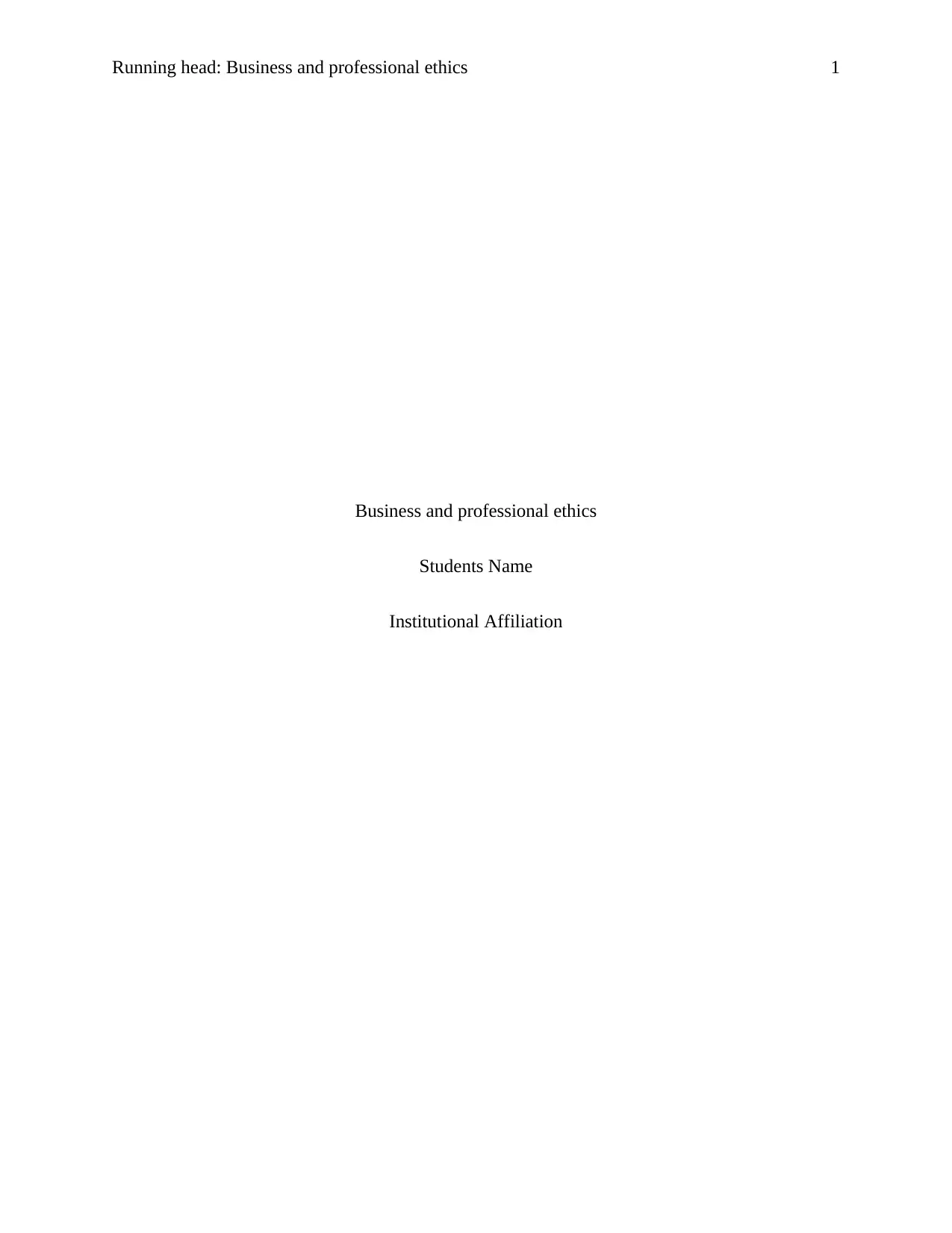
Running head: Business and professional ethics 1
Business and professional ethics
Students Name
Institutional Affiliation
Business and professional ethics
Students Name
Institutional Affiliation
Paraphrase This Document
Need a fresh take? Get an instant paraphrase of this document with our AI Paraphraser
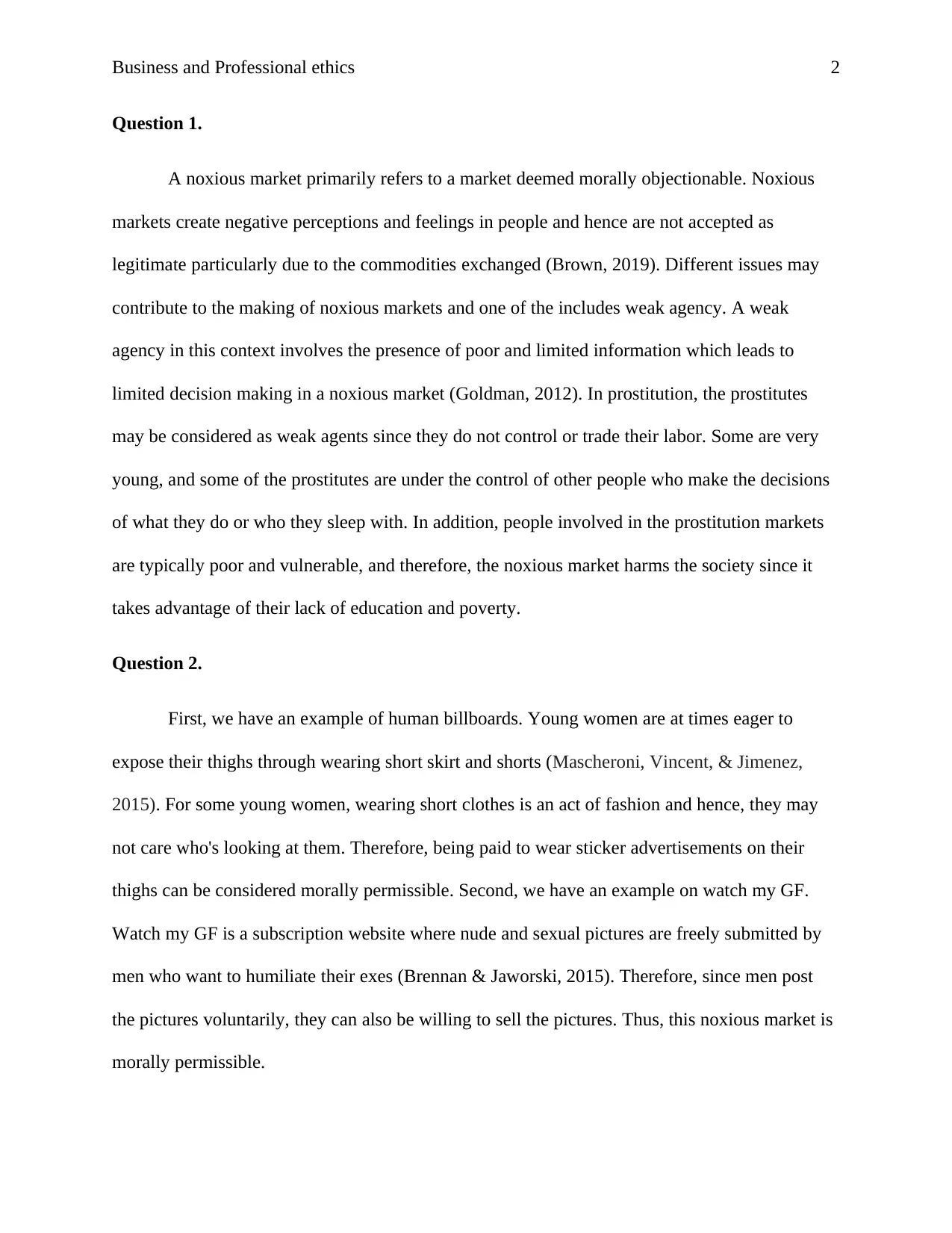
Business and Professional ethics 2
Question 1.
A noxious market primarily refers to a market deemed morally objectionable. Noxious
markets create negative perceptions and feelings in people and hence are not accepted as
legitimate particularly due to the commodities exchanged (Brown, 2019). Different issues may
contribute to the making of noxious markets and one of the includes weak agency. A weak
agency in this context involves the presence of poor and limited information which leads to
limited decision making in a noxious market (Goldman, 2012). In prostitution, the prostitutes
may be considered as weak agents since they do not control or trade their labor. Some are very
young, and some of the prostitutes are under the control of other people who make the decisions
of what they do or who they sleep with. In addition, people involved in the prostitution markets
are typically poor and vulnerable, and therefore, the noxious market harms the society since it
takes advantage of their lack of education and poverty.
Question 2.
First, we have an example of human billboards. Young women are at times eager to
expose their thighs through wearing short skirt and shorts (Mascheroni, Vincent, & Jimenez,
2015). For some young women, wearing short clothes is an act of fashion and hence, they may
not care who's looking at them. Therefore, being paid to wear sticker advertisements on their
thighs can be considered morally permissible. Second, we have an example on watch my GF.
Watch my GF is a subscription website where nude and sexual pictures are freely submitted by
men who want to humiliate their exes (Brennan & Jaworski, 2015). Therefore, since men post
the pictures voluntarily, they can also be willing to sell the pictures. Thus, this noxious market is
morally permissible.
Question 1.
A noxious market primarily refers to a market deemed morally objectionable. Noxious
markets create negative perceptions and feelings in people and hence are not accepted as
legitimate particularly due to the commodities exchanged (Brown, 2019). Different issues may
contribute to the making of noxious markets and one of the includes weak agency. A weak
agency in this context involves the presence of poor and limited information which leads to
limited decision making in a noxious market (Goldman, 2012). In prostitution, the prostitutes
may be considered as weak agents since they do not control or trade their labor. Some are very
young, and some of the prostitutes are under the control of other people who make the decisions
of what they do or who they sleep with. In addition, people involved in the prostitution markets
are typically poor and vulnerable, and therefore, the noxious market harms the society since it
takes advantage of their lack of education and poverty.
Question 2.
First, we have an example of human billboards. Young women are at times eager to
expose their thighs through wearing short skirt and shorts (Mascheroni, Vincent, & Jimenez,
2015). For some young women, wearing short clothes is an act of fashion and hence, they may
not care who's looking at them. Therefore, being paid to wear sticker advertisements on their
thighs can be considered morally permissible. Second, we have an example on watch my GF.
Watch my GF is a subscription website where nude and sexual pictures are freely submitted by
men who want to humiliate their exes (Brennan & Jaworski, 2015). Therefore, since men post
the pictures voluntarily, they can also be willing to sell the pictures. Thus, this noxious market is
morally permissible.
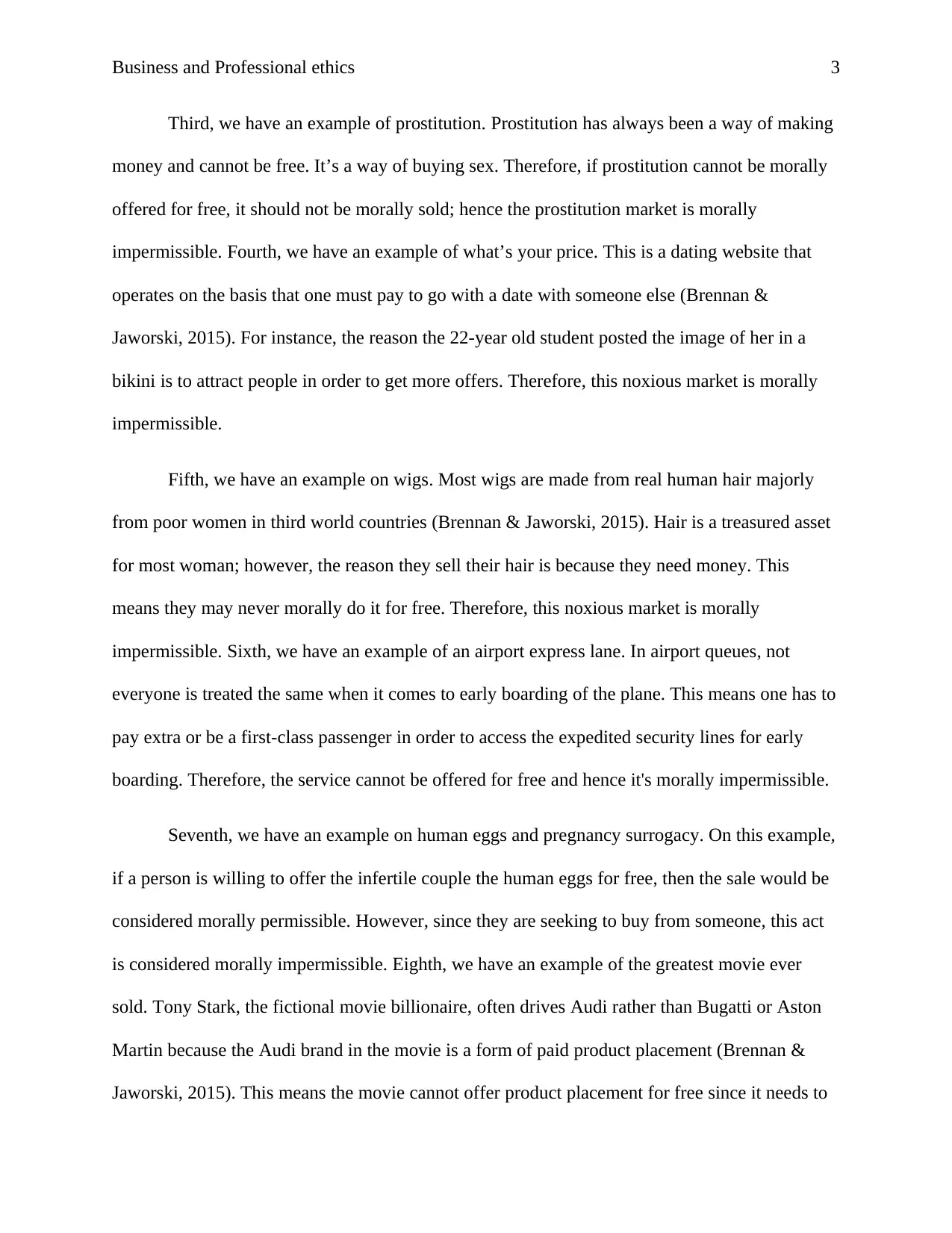
Business and Professional ethics 3
Third, we have an example of prostitution. Prostitution has always been a way of making
money and cannot be free. It’s a way of buying sex. Therefore, if prostitution cannot be morally
offered for free, it should not be morally sold; hence the prostitution market is morally
impermissible. Fourth, we have an example of what’s your price. This is a dating website that
operates on the basis that one must pay to go with a date with someone else (Brennan &
Jaworski, 2015). For instance, the reason the 22-year old student posted the image of her in a
bikini is to attract people in order to get more offers. Therefore, this noxious market is morally
impermissible.
Fifth, we have an example on wigs. Most wigs are made from real human hair majorly
from poor women in third world countries (Brennan & Jaworski, 2015). Hair is a treasured asset
for most woman; however, the reason they sell their hair is because they need money. This
means they may never morally do it for free. Therefore, this noxious market is morally
impermissible. Sixth, we have an example of an airport express lane. In airport queues, not
everyone is treated the same when it comes to early boarding of the plane. This means one has to
pay extra or be a first-class passenger in order to access the expedited security lines for early
boarding. Therefore, the service cannot be offered for free and hence it's morally impermissible.
Seventh, we have an example on human eggs and pregnancy surrogacy. On this example,
if a person is willing to offer the infertile couple the human eggs for free, then the sale would be
considered morally permissible. However, since they are seeking to buy from someone, this act
is considered morally impermissible. Eighth, we have an example of the greatest movie ever
sold. Tony Stark, the fictional movie billionaire, often drives Audi rather than Bugatti or Aston
Martin because the Audi brand in the movie is a form of paid product placement (Brennan &
Jaworski, 2015). This means the movie cannot offer product placement for free since it needs to
Third, we have an example of prostitution. Prostitution has always been a way of making
money and cannot be free. It’s a way of buying sex. Therefore, if prostitution cannot be morally
offered for free, it should not be morally sold; hence the prostitution market is morally
impermissible. Fourth, we have an example of what’s your price. This is a dating website that
operates on the basis that one must pay to go with a date with someone else (Brennan &
Jaworski, 2015). For instance, the reason the 22-year old student posted the image of her in a
bikini is to attract people in order to get more offers. Therefore, this noxious market is morally
impermissible.
Fifth, we have an example on wigs. Most wigs are made from real human hair majorly
from poor women in third world countries (Brennan & Jaworski, 2015). Hair is a treasured asset
for most woman; however, the reason they sell their hair is because they need money. This
means they may never morally do it for free. Therefore, this noxious market is morally
impermissible. Sixth, we have an example of an airport express lane. In airport queues, not
everyone is treated the same when it comes to early boarding of the plane. This means one has to
pay extra or be a first-class passenger in order to access the expedited security lines for early
boarding. Therefore, the service cannot be offered for free and hence it's morally impermissible.
Seventh, we have an example on human eggs and pregnancy surrogacy. On this example,
if a person is willing to offer the infertile couple the human eggs for free, then the sale would be
considered morally permissible. However, since they are seeking to buy from someone, this act
is considered morally impermissible. Eighth, we have an example of the greatest movie ever
sold. Tony Stark, the fictional movie billionaire, often drives Audi rather than Bugatti or Aston
Martin because the Audi brand in the movie is a form of paid product placement (Brennan &
Jaworski, 2015). This means the movie cannot offer product placement for free since it needs to
⊘ This is a preview!⊘
Do you want full access?
Subscribe today to unlock all pages.

Trusted by 1+ million students worldwide
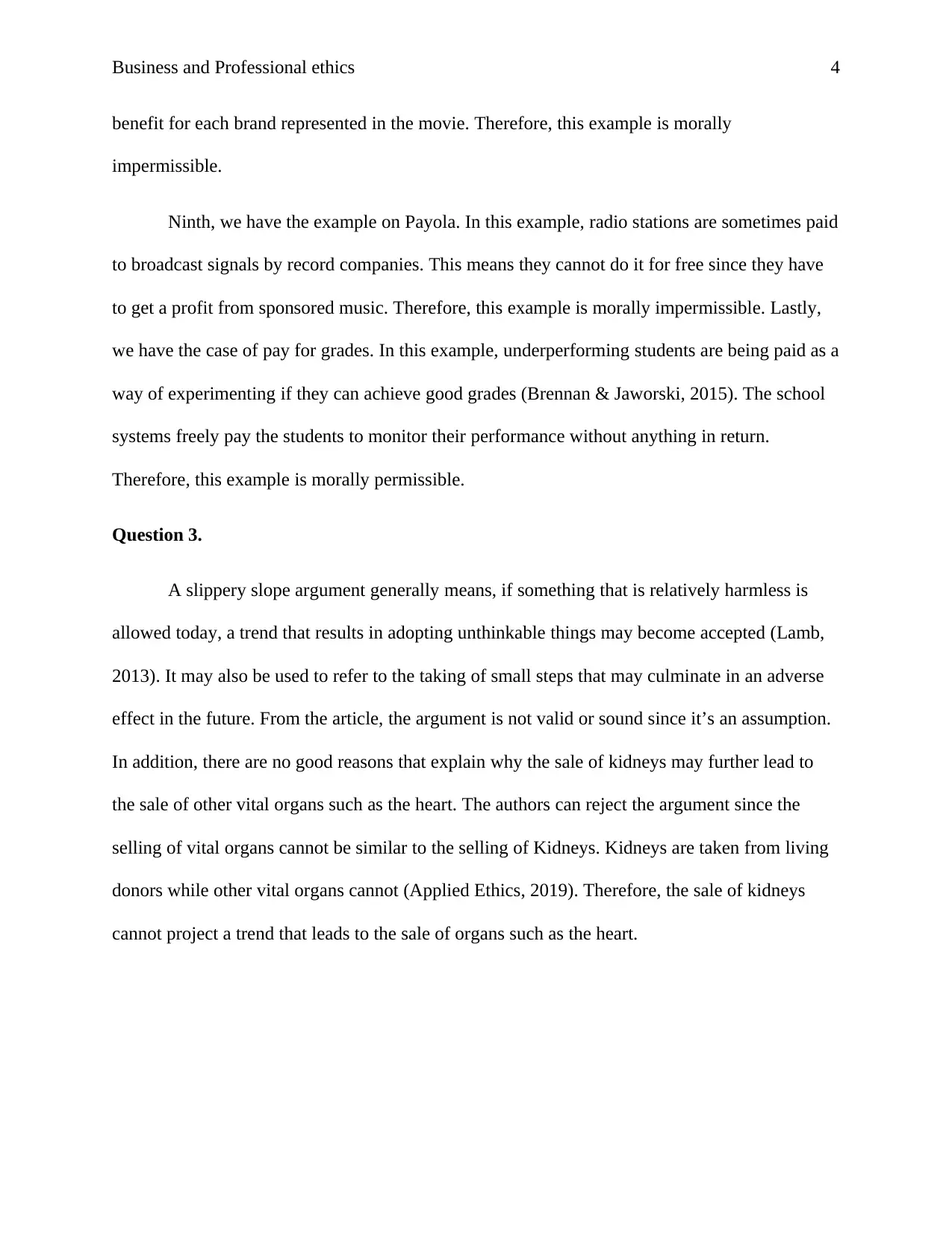
Business and Professional ethics 4
benefit for each brand represented in the movie. Therefore, this example is morally
impermissible.
Ninth, we have the example on Payola. In this example, radio stations are sometimes paid
to broadcast signals by record companies. This means they cannot do it for free since they have
to get a profit from sponsored music. Therefore, this example is morally impermissible. Lastly,
we have the case of pay for grades. In this example, underperforming students are being paid as a
way of experimenting if they can achieve good grades (Brennan & Jaworski, 2015). The school
systems freely pay the students to monitor their performance without anything in return.
Therefore, this example is morally permissible.
Question 3.
A slippery slope argument generally means, if something that is relatively harmless is
allowed today, a trend that results in adopting unthinkable things may become accepted (Lamb,
2013). It may also be used to refer to the taking of small steps that may culminate in an adverse
effect in the future. From the article, the argument is not valid or sound since it’s an assumption.
In addition, there are no good reasons that explain why the sale of kidneys may further lead to
the sale of other vital organs such as the heart. The authors can reject the argument since the
selling of vital organs cannot be similar to the selling of Kidneys. Kidneys are taken from living
donors while other vital organs cannot (Applied Ethics, 2019). Therefore, the sale of kidneys
cannot project a trend that leads to the sale of organs such as the heart.
benefit for each brand represented in the movie. Therefore, this example is morally
impermissible.
Ninth, we have the example on Payola. In this example, radio stations are sometimes paid
to broadcast signals by record companies. This means they cannot do it for free since they have
to get a profit from sponsored music. Therefore, this example is morally impermissible. Lastly,
we have the case of pay for grades. In this example, underperforming students are being paid as a
way of experimenting if they can achieve good grades (Brennan & Jaworski, 2015). The school
systems freely pay the students to monitor their performance without anything in return.
Therefore, this example is morally permissible.
Question 3.
A slippery slope argument generally means, if something that is relatively harmless is
allowed today, a trend that results in adopting unthinkable things may become accepted (Lamb,
2013). It may also be used to refer to the taking of small steps that may culminate in an adverse
effect in the future. From the article, the argument is not valid or sound since it’s an assumption.
In addition, there are no good reasons that explain why the sale of kidneys may further lead to
the sale of other vital organs such as the heart. The authors can reject the argument since the
selling of vital organs cannot be similar to the selling of Kidneys. Kidneys are taken from living
donors while other vital organs cannot (Applied Ethics, 2019). Therefore, the sale of kidneys
cannot project a trend that leads to the sale of organs such as the heart.
Paraphrase This Document
Need a fresh take? Get an instant paraphrase of this document with our AI Paraphraser
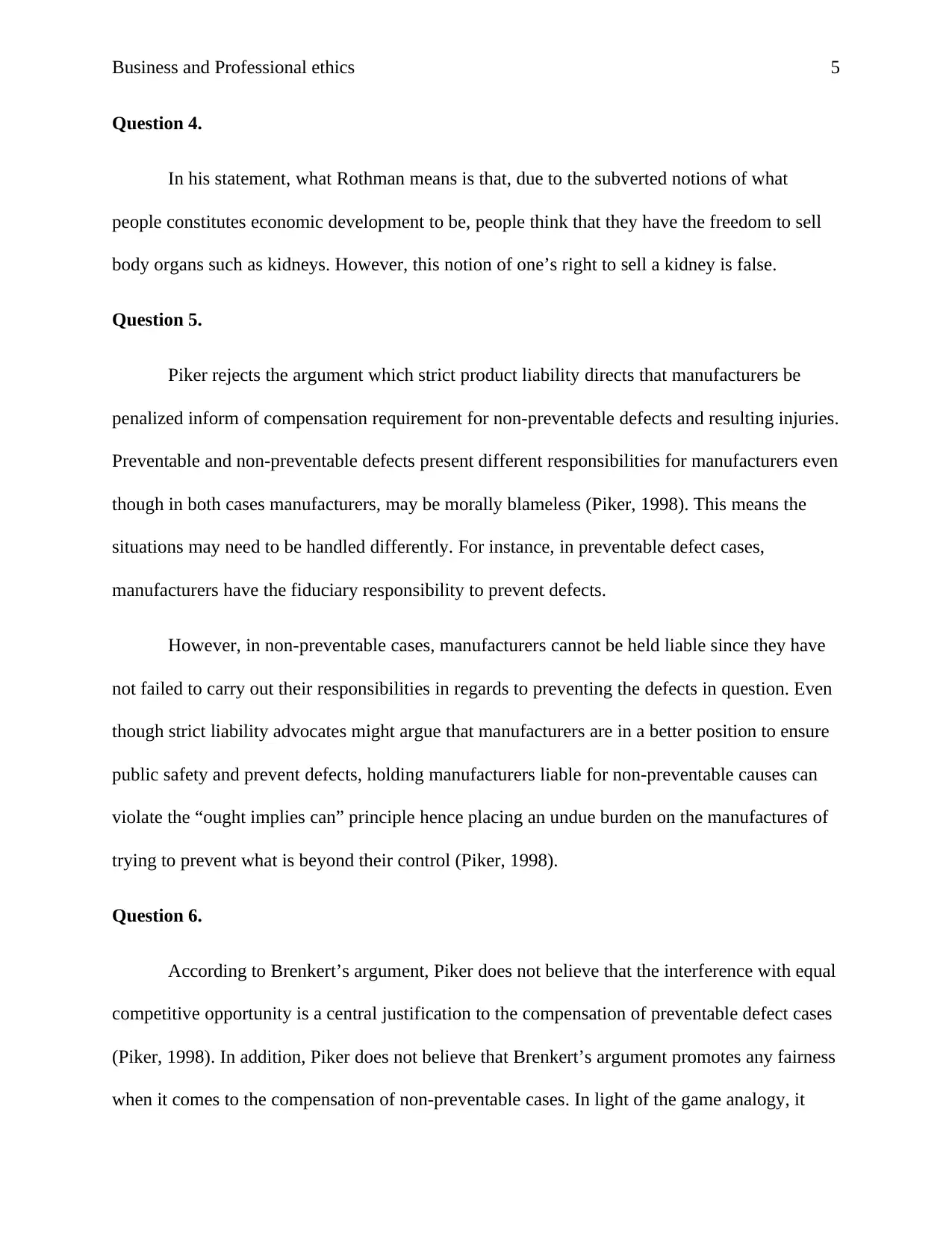
Business and Professional ethics 5
Question 4.
In his statement, what Rothman means is that, due to the subverted notions of what
people constitutes economic development to be, people think that they have the freedom to sell
body organs such as kidneys. However, this notion of one’s right to sell a kidney is false.
Question 5.
Piker rejects the argument which strict product liability directs that manufacturers be
penalized inform of compensation requirement for non-preventable defects and resulting injuries.
Preventable and non-preventable defects present different responsibilities for manufacturers even
though in both cases manufacturers, may be morally blameless (Piker, 1998). This means the
situations may need to be handled differently. For instance, in preventable defect cases,
manufacturers have the fiduciary responsibility to prevent defects.
However, in non-preventable cases, manufacturers cannot be held liable since they have
not failed to carry out their responsibilities in regards to preventing the defects in question. Even
though strict liability advocates might argue that manufacturers are in a better position to ensure
public safety and prevent defects, holding manufacturers liable for non-preventable causes can
violate the “ought implies can” principle hence placing an undue burden on the manufactures of
trying to prevent what is beyond their control (Piker, 1998).
Question 6.
According to Brenkert’s argument, Piker does not believe that the interference with equal
competitive opportunity is a central justification to the compensation of preventable defect cases
(Piker, 1998). In addition, Piker does not believe that Brenkert’s argument promotes any fairness
when it comes to the compensation of non-preventable cases. In light of the game analogy, it
Question 4.
In his statement, what Rothman means is that, due to the subverted notions of what
people constitutes economic development to be, people think that they have the freedom to sell
body organs such as kidneys. However, this notion of one’s right to sell a kidney is false.
Question 5.
Piker rejects the argument which strict product liability directs that manufacturers be
penalized inform of compensation requirement for non-preventable defects and resulting injuries.
Preventable and non-preventable defects present different responsibilities for manufacturers even
though in both cases manufacturers, may be morally blameless (Piker, 1998). This means the
situations may need to be handled differently. For instance, in preventable defect cases,
manufacturers have the fiduciary responsibility to prevent defects.
However, in non-preventable cases, manufacturers cannot be held liable since they have
not failed to carry out their responsibilities in regards to preventing the defects in question. Even
though strict liability advocates might argue that manufacturers are in a better position to ensure
public safety and prevent defects, holding manufacturers liable for non-preventable causes can
violate the “ought implies can” principle hence placing an undue burden on the manufactures of
trying to prevent what is beyond their control (Piker, 1998).
Question 6.
According to Brenkert’s argument, Piker does not believe that the interference with equal
competitive opportunity is a central justification to the compensation of preventable defect cases
(Piker, 1998). In addition, Piker does not believe that Brenkert’s argument promotes any fairness
when it comes to the compensation of non-preventable cases. In light of the game analogy, it
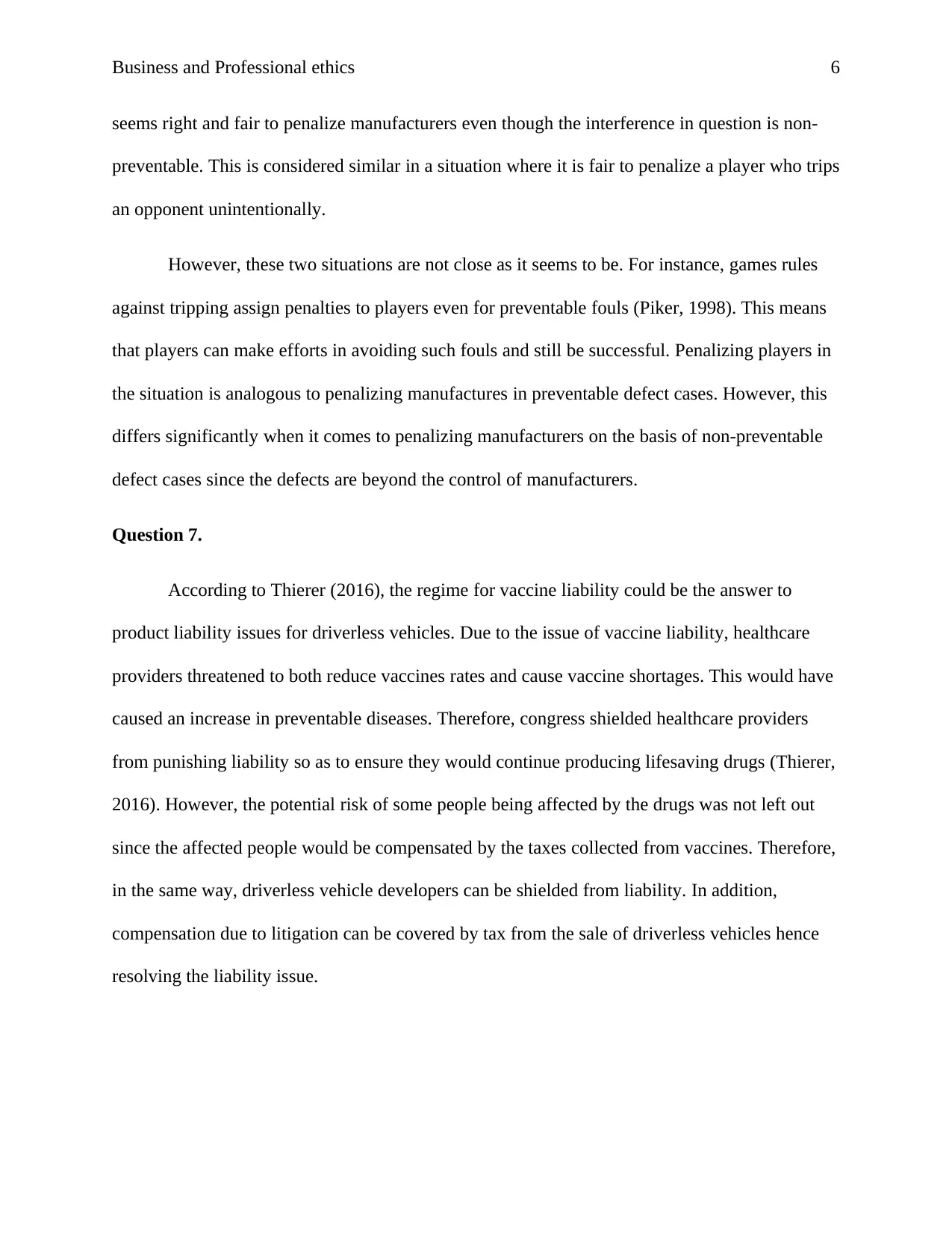
Business and Professional ethics 6
seems right and fair to penalize manufacturers even though the interference in question is non-
preventable. This is considered similar in a situation where it is fair to penalize a player who trips
an opponent unintentionally.
However, these two situations are not close as it seems to be. For instance, games rules
against tripping assign penalties to players even for preventable fouls (Piker, 1998). This means
that players can make efforts in avoiding such fouls and still be successful. Penalizing players in
the situation is analogous to penalizing manufactures in preventable defect cases. However, this
differs significantly when it comes to penalizing manufacturers on the basis of non-preventable
defect cases since the defects are beyond the control of manufacturers.
Question 7.
According to Thierer (2016), the regime for vaccine liability could be the answer to
product liability issues for driverless vehicles. Due to the issue of vaccine liability, healthcare
providers threatened to both reduce vaccines rates and cause vaccine shortages. This would have
caused an increase in preventable diseases. Therefore, congress shielded healthcare providers
from punishing liability so as to ensure they would continue producing lifesaving drugs (Thierer,
2016). However, the potential risk of some people being affected by the drugs was not left out
since the affected people would be compensated by the taxes collected from vaccines. Therefore,
in the same way, driverless vehicle developers can be shielded from liability. In addition,
compensation due to litigation can be covered by tax from the sale of driverless vehicles hence
resolving the liability issue.
seems right and fair to penalize manufacturers even though the interference in question is non-
preventable. This is considered similar in a situation where it is fair to penalize a player who trips
an opponent unintentionally.
However, these two situations are not close as it seems to be. For instance, games rules
against tripping assign penalties to players even for preventable fouls (Piker, 1998). This means
that players can make efforts in avoiding such fouls and still be successful. Penalizing players in
the situation is analogous to penalizing manufactures in preventable defect cases. However, this
differs significantly when it comes to penalizing manufacturers on the basis of non-preventable
defect cases since the defects are beyond the control of manufacturers.
Question 7.
According to Thierer (2016), the regime for vaccine liability could be the answer to
product liability issues for driverless vehicles. Due to the issue of vaccine liability, healthcare
providers threatened to both reduce vaccines rates and cause vaccine shortages. This would have
caused an increase in preventable diseases. Therefore, congress shielded healthcare providers
from punishing liability so as to ensure they would continue producing lifesaving drugs (Thierer,
2016). However, the potential risk of some people being affected by the drugs was not left out
since the affected people would be compensated by the taxes collected from vaccines. Therefore,
in the same way, driverless vehicle developers can be shielded from liability. In addition,
compensation due to litigation can be covered by tax from the sale of driverless vehicles hence
resolving the liability issue.
⊘ This is a preview!⊘
Do you want full access?
Subscribe today to unlock all pages.

Trusted by 1+ million students worldwide
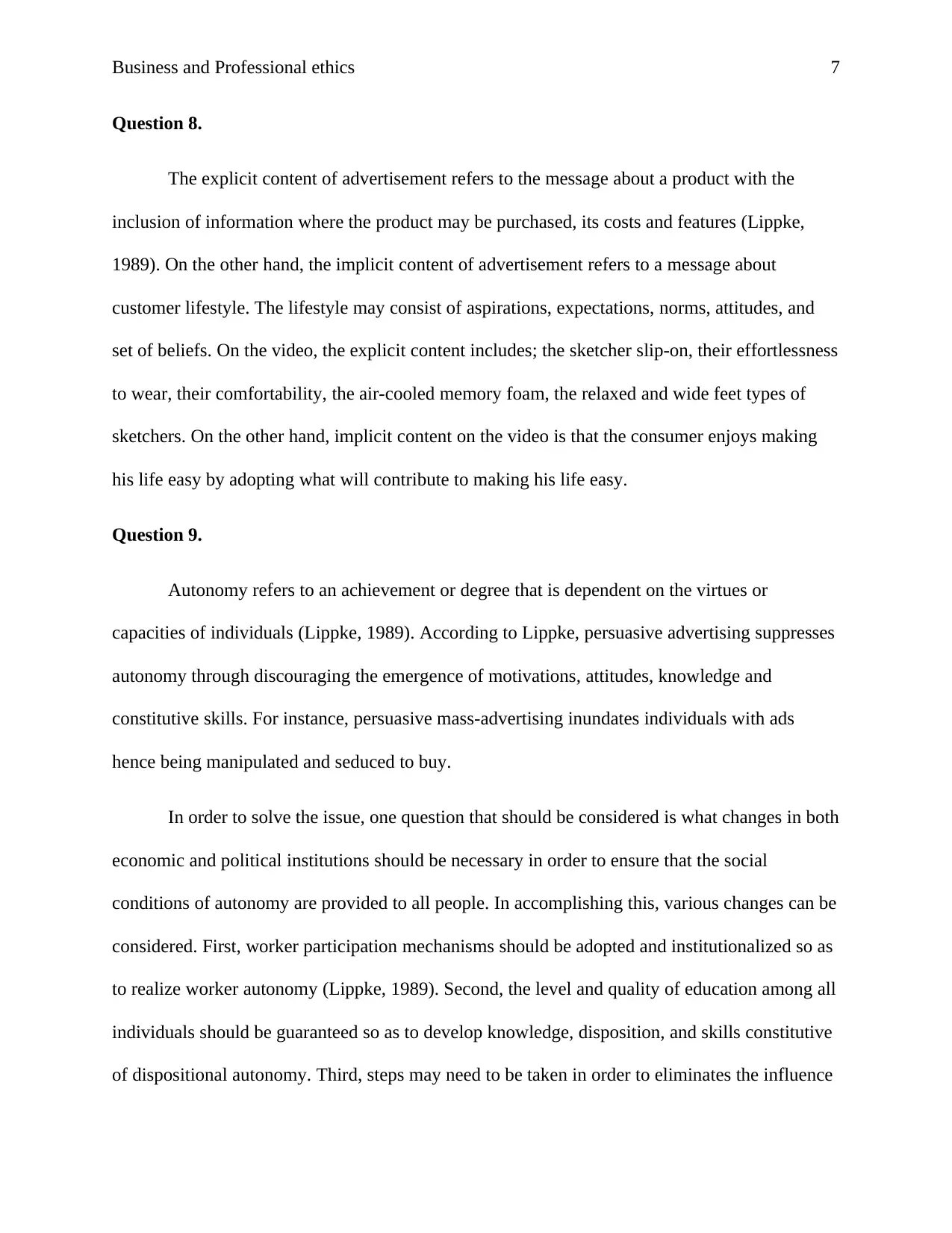
Business and Professional ethics 7
Question 8.
The explicit content of advertisement refers to the message about a product with the
inclusion of information where the product may be purchased, its costs and features (Lippke,
1989). On the other hand, the implicit content of advertisement refers to a message about
customer lifestyle. The lifestyle may consist of aspirations, expectations, norms, attitudes, and
set of beliefs. On the video, the explicit content includes; the sketcher slip-on, their effortlessness
to wear, their comfortability, the air-cooled memory foam, the relaxed and wide feet types of
sketchers. On the other hand, implicit content on the video is that the consumer enjoys making
his life easy by adopting what will contribute to making his life easy.
Question 9.
Autonomy refers to an achievement or degree that is dependent on the virtues or
capacities of individuals (Lippke, 1989). According to Lippke, persuasive advertising suppresses
autonomy through discouraging the emergence of motivations, attitudes, knowledge and
constitutive skills. For instance, persuasive mass-advertising inundates individuals with ads
hence being manipulated and seduced to buy.
In order to solve the issue, one question that should be considered is what changes in both
economic and political institutions should be necessary in order to ensure that the social
conditions of autonomy are provided to all people. In accomplishing this, various changes can be
considered. First, worker participation mechanisms should be adopted and institutionalized so as
to realize worker autonomy (Lippke, 1989). Second, the level and quality of education among all
individuals should be guaranteed so as to develop knowledge, disposition, and skills constitutive
of dispositional autonomy. Third, steps may need to be taken in order to eliminates the influence
Question 8.
The explicit content of advertisement refers to the message about a product with the
inclusion of information where the product may be purchased, its costs and features (Lippke,
1989). On the other hand, the implicit content of advertisement refers to a message about
customer lifestyle. The lifestyle may consist of aspirations, expectations, norms, attitudes, and
set of beliefs. On the video, the explicit content includes; the sketcher slip-on, their effortlessness
to wear, their comfortability, the air-cooled memory foam, the relaxed and wide feet types of
sketchers. On the other hand, implicit content on the video is that the consumer enjoys making
his life easy by adopting what will contribute to making his life easy.
Question 9.
Autonomy refers to an achievement or degree that is dependent on the virtues or
capacities of individuals (Lippke, 1989). According to Lippke, persuasive advertising suppresses
autonomy through discouraging the emergence of motivations, attitudes, knowledge and
constitutive skills. For instance, persuasive mass-advertising inundates individuals with ads
hence being manipulated and seduced to buy.
In order to solve the issue, one question that should be considered is what changes in both
economic and political institutions should be necessary in order to ensure that the social
conditions of autonomy are provided to all people. In accomplishing this, various changes can be
considered. First, worker participation mechanisms should be adopted and institutionalized so as
to realize worker autonomy (Lippke, 1989). Second, the level and quality of education among all
individuals should be guaranteed so as to develop knowledge, disposition, and skills constitutive
of dispositional autonomy. Third, steps may need to be taken in order to eliminates the influence
Paraphrase This Document
Need a fresh take? Get an instant paraphrase of this document with our AI Paraphraser
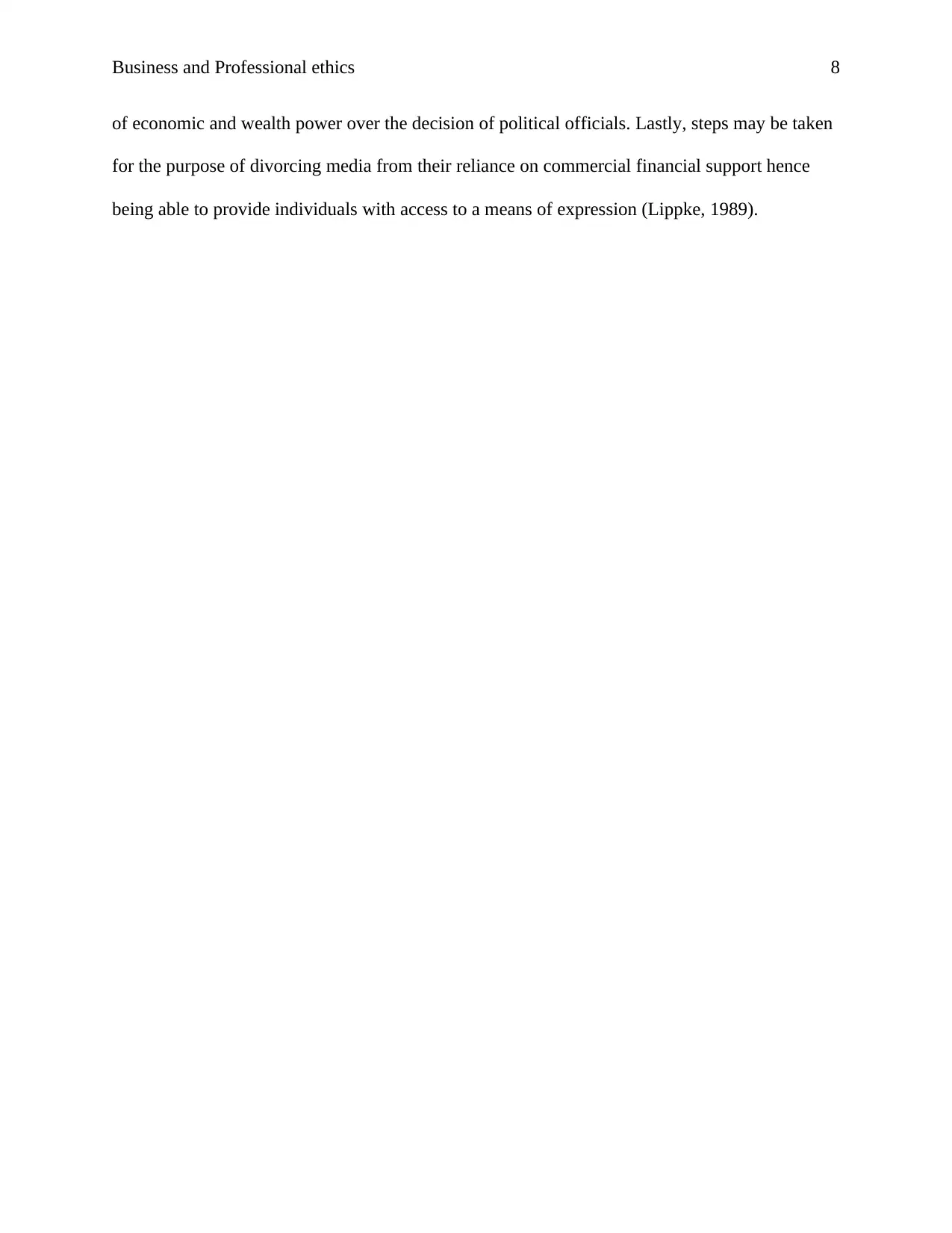
Business and Professional ethics 8
of economic and wealth power over the decision of political officials. Lastly, steps may be taken
for the purpose of divorcing media from their reliance on commercial financial support hence
being able to provide individuals with access to a means of expression (Lippke, 1989).
of economic and wealth power over the decision of political officials. Lastly, steps may be taken
for the purpose of divorcing media from their reliance on commercial financial support hence
being able to provide individuals with access to a means of expression (Lippke, 1989).
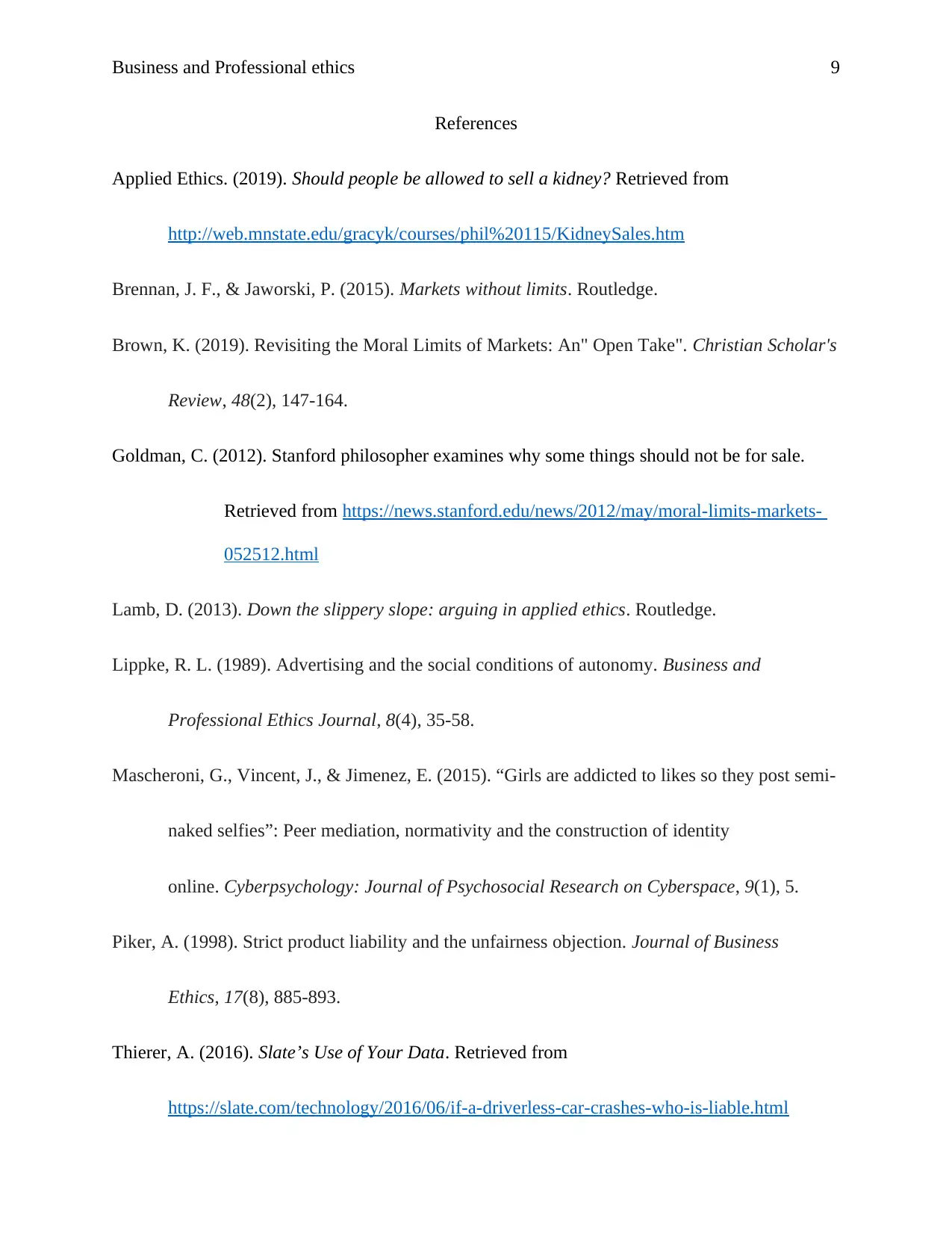
Business and Professional ethics 9
References
Applied Ethics. (2019). Should people be allowed to sell a kidney? Retrieved from
http://web.mnstate.edu/gracyk/courses/phil%20115/KidneySales.htm
Brennan, J. F., & Jaworski, P. (2015). Markets without limits. Routledge.
Brown, K. (2019). Revisiting the Moral Limits of Markets: An" Open Take". Christian Scholar's
Review, 48(2), 147-164.
Goldman, C. (2012). Stanford philosopher examines why some things should not be for sale.
Retrieved from https://news.stanford.edu/news/2012/may/moral-limits-markets-
052512.html
Lamb, D. (2013). Down the slippery slope: arguing in applied ethics. Routledge.
Lippke, R. L. (1989). Advertising and the social conditions of autonomy. Business and
Professional Ethics Journal, 8(4), 35-58.
Mascheroni, G., Vincent, J., & Jimenez, E. (2015). “Girls are addicted to likes so they post semi-
naked selfies”: Peer mediation, normativity and the construction of identity
online. Cyberpsychology: Journal of Psychosocial Research on Cyberspace, 9(1), 5.
Piker, A. (1998). Strict product liability and the unfairness objection. Journal of Business
Ethics, 17(8), 885-893.
Thierer, A. (2016). Slate’s Use of Your Data. Retrieved from
https://slate.com/technology/2016/06/if-a-driverless-car-crashes-who-is-liable.html
References
Applied Ethics. (2019). Should people be allowed to sell a kidney? Retrieved from
http://web.mnstate.edu/gracyk/courses/phil%20115/KidneySales.htm
Brennan, J. F., & Jaworski, P. (2015). Markets without limits. Routledge.
Brown, K. (2019). Revisiting the Moral Limits of Markets: An" Open Take". Christian Scholar's
Review, 48(2), 147-164.
Goldman, C. (2012). Stanford philosopher examines why some things should not be for sale.
Retrieved from https://news.stanford.edu/news/2012/may/moral-limits-markets-
052512.html
Lamb, D. (2013). Down the slippery slope: arguing in applied ethics. Routledge.
Lippke, R. L. (1989). Advertising and the social conditions of autonomy. Business and
Professional Ethics Journal, 8(4), 35-58.
Mascheroni, G., Vincent, J., & Jimenez, E. (2015). “Girls are addicted to likes so they post semi-
naked selfies”: Peer mediation, normativity and the construction of identity
online. Cyberpsychology: Journal of Psychosocial Research on Cyberspace, 9(1), 5.
Piker, A. (1998). Strict product liability and the unfairness objection. Journal of Business
Ethics, 17(8), 885-893.
Thierer, A. (2016). Slate’s Use of Your Data. Retrieved from
https://slate.com/technology/2016/06/if-a-driverless-car-crashes-who-is-liable.html
⊘ This is a preview!⊘
Do you want full access?
Subscribe today to unlock all pages.

Trusted by 1+ million students worldwide
1 out of 9
Your All-in-One AI-Powered Toolkit for Academic Success.
+13062052269
info@desklib.com
Available 24*7 on WhatsApp / Email
![[object Object]](/_next/static/media/star-bottom.7253800d.svg)
Unlock your academic potential
Copyright © 2020–2025 A2Z Services. All Rights Reserved. Developed and managed by ZUCOL.